7.2: History of Rockets
- Page ID
- 30890
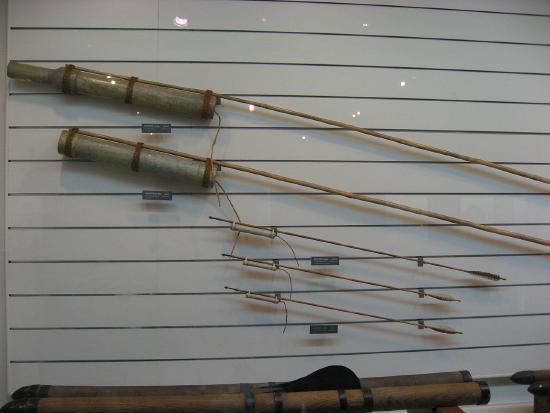 Korean rocket arrows.
Korean rocket arrows.
https:/upload.wikimedia.org/wikipedia/commons/e/e7/Korean_rocket_arrows.jpg;
7.2.1 Origins of Rocketry
The earliest rockets consisted of bamboo tubes filled with gunpowder, a mixture of sulfur, charcoal, and saltpeter. The first recorded use of gunpowder dates to the 3rd century BCE in China. By 1045 CE, the Chinese were routinely using rockets in their military tactics. In 1232 AD, the Sung Dynasty used rockets to repel Mongol invaders. The Mongols saw a good idea and adopted rockets. By 1245, they used rockets to attack the Magyars in what is now Hungary. Arab records show the Mongols also used rockets to attack Baghdad in 1258. Soon, the Arabs also adopted rockets and in 1268 they used rockets against the French forces of Louis IX during the Seventh Crusade. By 1300, Europeans were using rockets in warfare. Then, the French used rockets against the English during the siege of Orleans in the Hundred Years War. Rockets continue to be used as tool of war in the coming centuries, improving in both power and accuracy. In the Nineteenth Century, Sir William Congreve designed rockets that were used against Napoleon.
While rockets remained primarily a weapon of war, there is at least one legend of an attempt to use rockets to travel into space from the 16th century. Wan Hu attached 47 fire-arrow rockets to two large kites and a wicker chair. Thinking it would propel him into space, he sat in the chair, while his 47 assistants each lit a rocket. The rockets fired with a huge bang and, after the smoke clear, Wan Hu and his chair were gone! Assuming the legend of Wan Hu is not just a myth, it is, unfortunately, unlikely that he survived his attempted space journey.
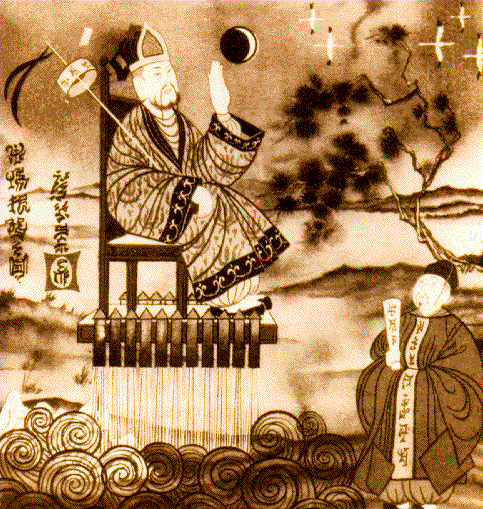 Wan Hu: According to legend, Wan Hu attempted to journey into space with 47 rockets attached to his chair.
Wan Hu: According to legend, Wan Hu attempted to journey into space with 47 rockets attached to his chair.
As immortalized in the lyrics of the Star-Spangled Banner, rockets played a role in warfare almost from the founding of the United States of America. Rockets came to the New World during the War of 1812. Later, Captain Robert E. Lee used rockets at the Battle of Telegraph Hill during the Mexican American War. The first recorded use of rockets in the Civil War came on July 3, 1862, when Maj. Gen. J.E.B. Stuart's Confederate cavalry fired rockets at Maj. Gen. George B. McClellan's Union troops at Harrison's Landing, Virginia. Later in 1862, an attempt was made by the Union Army's New York Rocket Battalion -- 160 men under the command of British-born Major Thomas W. Lion -- to use rockets against Confederates defending Richmond and Yorktown, Virginia. The first attempt did not go well. When ignited, the rockets skittered wildly across the ground, passing between the legs of several mules. One detonated harmlessly under a mule, lifting the animal several feet off the ground and, according to written accounts of the incident, prompted the mule’s immediate defection the Confederacy. Nonetheless, rockets continued to play a role in warfare through the 20th century.
 https:/www.pikist.com/free-photo-ixvdn;
https:/www.pikist.com/free-photo-ixvdn; 7.2.2 Robert Goddard
Up until the early 20th century, rockets still used only solid fuel (mostly gunpowder) and were pretty “dumb” and inaccurate. Armies would fire a multitude of rockets at a target in the hope at a few with hit. Given the devastating potential of rockets, this proved to be an effective strategy. Still, some rocket scientist began to experiment with liquid fuel rockets and methods to them more accurate, both for warfare and for the potential use for traveling into the space.
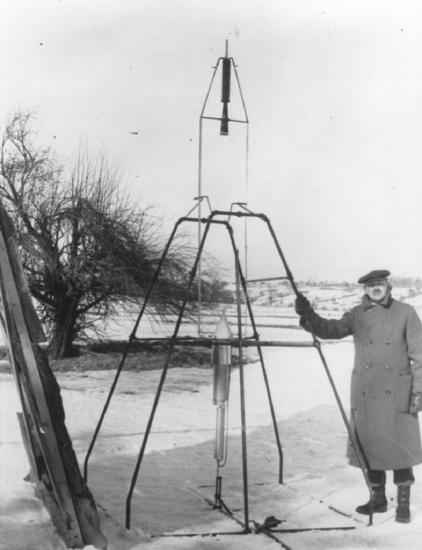 Robert Goddard was the one the first American pioneers in experimental rocketry.
Robert Goddard was the one the first American pioneers in experimental rocketry.
https:/www.flickr.com/photos/gsfc/4245368270;
In 1914, Robert Goddard received two U.S. patents, one for a rocket using liquid fuel. The other involved a two- or three-stage rocket using solid fuel. In 1920, Goddard proposed using rockets to travel to the moon, for which he was ridiculed in the New York Times for it. The Times editorial board, apparently not understanding Newton’s Laws of Motion, could not work in space because there was nothing to “push against.” Undeterred, Goddard explored the practicality of using rocket propulsion to reach high altitudes, even the moon. He eventually proved that a rocket will work in a vacuum and that it needs no air to push against. He also developed and fired a liquid fuel rocket on March 16, 1926 in Auburn, Massachusetts. He later shot a scientific payload in a rocket flight in 1929. In addition, in 1932 in New Mexico, he used vanes in the rocket motor blast for guidance and provide for a more stable flight. Other advances Goddard pioneered in 1932 included a gyro control apparatus for rocket flight and developed pumps suitable for rocket fuels. In 1937, he launched a rocket with a motor pivoted on gimbals under the influence of his gyro mechanism. With this research, Goddard helped make rockets more reliable and stable and he became known as the “Father of American Rocketry.”
7.2.3 Wernher von Braun
Meanwhile, as war brewed across Europe, another rocket scientist conducted research on building more powerful and reliable rockets for the Germans. Wernher von Braun developed the A-4 rocket for the Germans. Renamed the Vengeance Rocket Number Two, or the V-2, it became the first successful, long-range ballistic missile. Toward the end of WW II, the Nazis feared von Braun might fall into the hands of the allies and marked von Braun and his team for death. Von Braun considered his options and decided to defect to the Americans. Through what became known as Operation Paperclip, von Braun and his team the Allies recruited von Braun and his team and brought to White Sands, NM. The Soviets were more aggressive, having recruited over 2,200 German scientists and specialists.
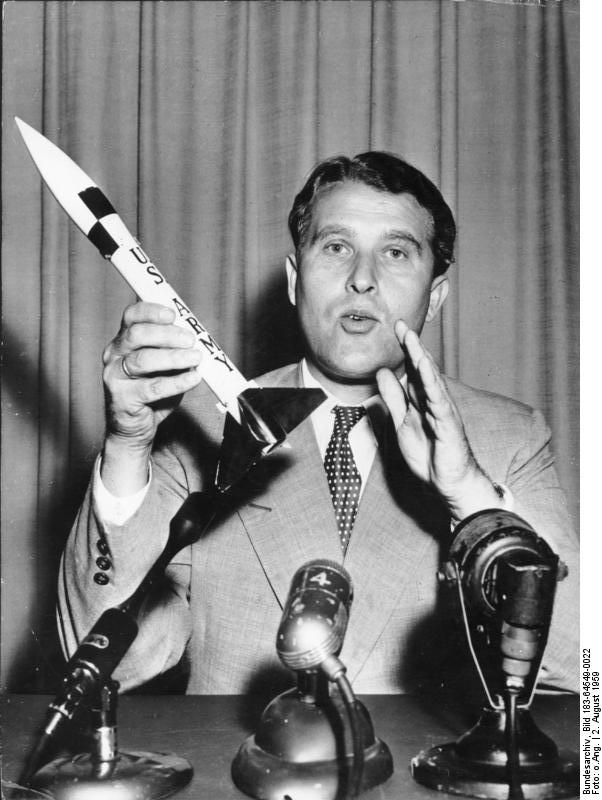 After building rockets as weapons for the Germans in WW II, Wernher von Braun defected to the United States and helped build rockets for America's early space program.
After building rockets as weapons for the Germans in WW II, Wernher von Braun defected to the United States and helped build rockets for America's early space program.
https:/commons.wikimedia.org/wiki/File:Bundesarchiv_Bild_183-64549-0022,_Wernher_von_Braun.jpg;
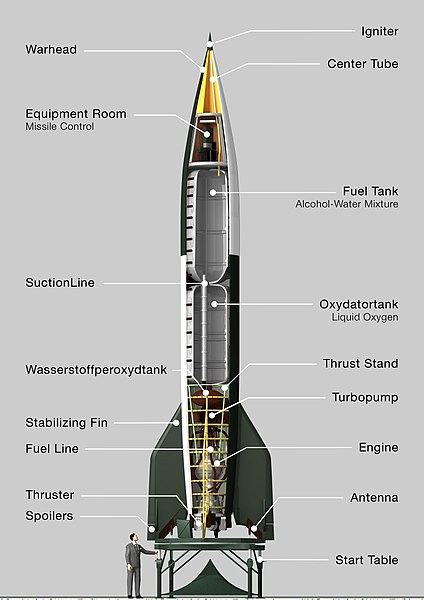 An early ICBM rocket design. Rockets such as these were adapted for use in the Mercury program.
An early ICBM rocket design. Rockets such as these were adapted for use in the Mercury program.
https:/commons.wikimedia.org/wiki/File:Aggregat4-Schnitt-engl.jpg;
Goddard died in 1945, leaving von Braun as America’s principle rocket scientist. Despite his work developing weapons of war for the Nazis, von Braun shared Goddard’s dream of using rockets to travel to other planets. Over the coming decades, von Braun would publish papers describing his theories using 1950s and 1960s technology to travel to Mars and beyond. Initially, though, von Braun and his team worked on ballistic missiles for the U. S. military, including missiles to deliver the fledgling nuclear weapons as the Cold War began in earnest. Eventually, the space race began, and von Braun and his team developed early American rockets like the Bumper, Redstone, and the Jupiter C that were based on his V-2 designs.
7.2.4 The Space Race Begins
Then, in 1957, the Soviet Union launched Sputnik I, the first human-made satellite. The space race was on and America established the National Aeronautics and Space Administration (NASA) in 1958. The federal government transferred von Braun and his team to NASA to work on rockets for space.
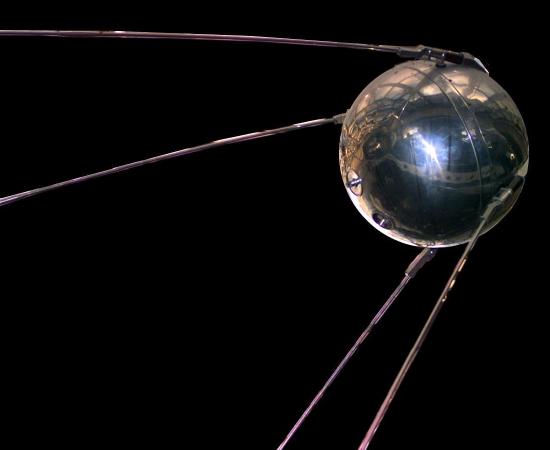 The launch of the Soviet Union's Sputnik I satellite triggered the space race.
The launch of the Soviet Union's Sputnik I satellite triggered the space race.
https:/www.needpix.com/photo/934/sputnik-satellite-astronautics-nasa-cosmonautics-space-flight-space-travel-aerospace-technology;
On April 12, 1961, Yuri Gagarin became the first human in space, flying a complete orbit around the Earth. A few weeks later, on May 5, 1961, Alan Shepherd rode a Redstone rocket to become the first American in space in a suborbital launch as part of the Mercury Program.
.jpg?revision=1) Yuri Gagarin, the first man in space.
Yuri Gagarin, the first man in space.
https:/commons.wikimedia.org/wiki/File:Gagarin_(cropped).jpg;
 Alan Shepard, the first American launched into space.
Alan Shepard, the first American launched into space.
https:/www.nasa.gov/sites/default/files/alanshepard_1.jpg;
The Mercury Program had 20 unmanned launches and six manned missions; each involved a capsule designed for a single occupant. Highlights of the Mercury Program include:
- January 21, 1961: Mercury-Redstone-2 launched with Ham the chimp on board.
- February 21, 1961: The improved Atlas-2 rocket was the first successful Atlas launch.
- May 5, 1961: Mercury-3 is launched with Alan Shepard on board.
- November 29, 1961: The Atlas-5 is launched with Enos the chimp on board.
- July 24, 1961: Mercury-Redstone-4 launched with Gus Grissom on board.
- February 20, 1962: The Mercury-Atlas-6 is launched. John Glenn becomes the first American to orbit the Earth.
The Redstone rocket consisted of a single-stage vehicle. It used ethyl alcohol and liquid oxygen for fuel. All the suborbital flights of the Mercury Program used the Redstone while the orbital flights used the Atlas. The Atlas-D came from a modified ballistic missile and used RP-1 (refined form of kerosene) and liquid oxygen (LOX) with a first stage and a booster.
.jpg?revision=1) The Mercury Redstone Rocket was used in several early space missions.
The Mercury Redstone Rocket was used in several early space missions.
https:/commons.wikimedia.org/wiki/File:Mercury-Redstone_Rocket_%E2%80%93_Johnson_Space_Center._20-3-2017_(40673408212).jpg;
After Mercury, NASA switched to the Gemini Program, which used a two-man capsule. The Gemini program had two uncrewed launches and ten crewed missions using the Titan II launch vehicle, a modified intercontinental ballistic missile (ICBM). The Titan family used two stages fueled by RP-1 and LOX (liquid oxygen). NASA used Gemini to practice EVA activities and docking maneuvers.
Cold War politics played a major role in the development of America’s space program. The Soviets had beaten America to launching the first man-made satellite (Sputnik I), first living organism in space (Laika, the dog on board Sputnik II), and the first man in space (Gagarin). In 1961, President Kennedy decided America needed a mission that would show up the Soviets and put America ahead in the space race. So, he issued his famous challenged for putting a man on the Moon by the end of the 1960s. Thus, the Apollo Program was born.
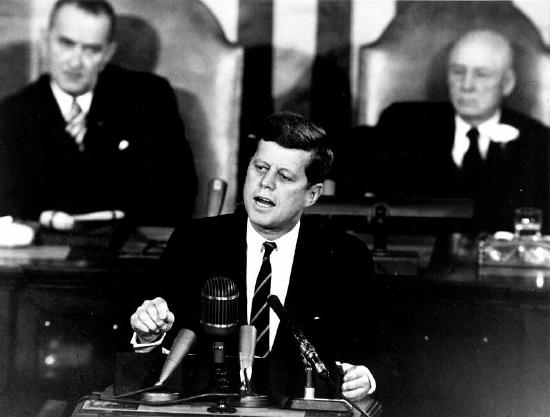 President Kennedy challenged Americans to reach the Moon.
President Kennedy challenged Americans to reach the Moon.
https:/www.flickr.com/photos/my_american_odyssey/6531810327;
For the Apollo Program, NASA needed a more powerful rocket, so von Braun and his team developed the Saturn rocket family. For all the manned Apollo missions, NASA used the Saturn V rocket. The Saturn V consisted of a three-stage rocket. Stage 1 used RP-1/LOX while stages 2 and 3 used liquid hydrogen (LH2) and LOX. The last use of the Saturn V was to launch Skylab, America’s first orbiting space station. With the close of the Apollo Program, NASA retired the Saturn V to focus on developing the space shuttle.
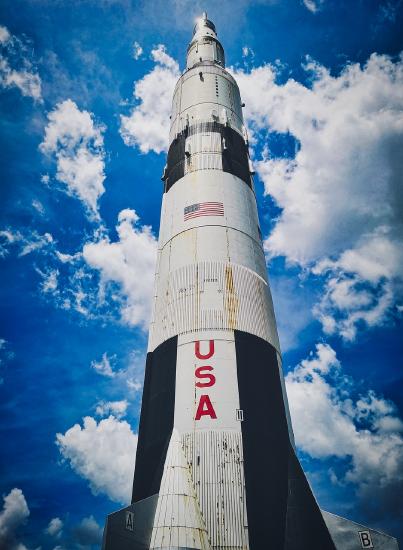 The Saturn V, the most powerful rocket ever built, was used for the Apollo missions
The Saturn V, the most powerful rocket ever built, was used for the Apollo missions
https:/pixabay.com/photos/rocket-nasa-saturn-v-forward-space-3776927;
NASA developed the space shuttle in the 1970s as a reusable launch vehicle and low orbital spacecraft. It consisted of an orbiter with an external LH2/LOX and two solid fuel boosters using ammonium perchlorate composite (APCP) solid fuel. APCP is a rubbery mixture that contains both the fuel and the oxidizer. While the boosters parachuted and were recovered after launch, the fuel tank was expendable. As a result, the shuttle never truly achieved its initial goal of total reusability. After a write in campaign from fans of Star Trek, NASA named shuttle built the Enterprise, a test vehicle with no orbital capabilities. NASA used the Enterprise to test the shuttle’s flight and landing systems before launching one into space. NASA initially produced four orbital space shuttles: Columbia, Challenger, Discovery, and Atlantis. Each was used to conduct experiments in space and launch satellites and interplanetary probes. Challenger exploded during launch in 1986 and NASA built the Endeavor to replace Challenger in 1991. Then, Columbia broke apart during reentry in 2003. Both accidents resulted in the loss of their respective crews. After 133 successful missions, NASA retired the shuttle program with the final launch of Atlantis in 2011.
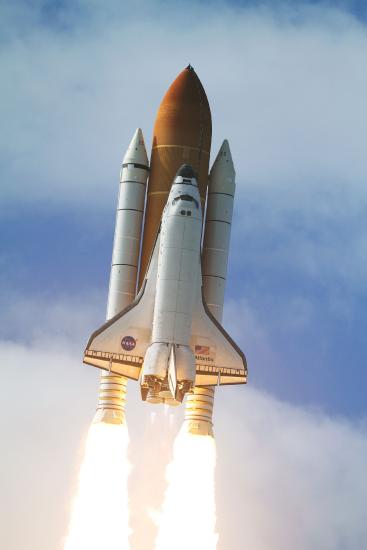 The Space Shuttle was NASA's primary launch vehicle and sole crewed vehicle from 1980 until 2011.
The Space Shuttle was NASA's primary launch vehicle and sole crewed vehicle from 1980 until 2011.
https:/pixy.org/368501;
7.2.5 Twenty-First Century Space Travel
While NASA had proposed several potential replacements for the shuttle, none of them survived budget cuts by 2011. This left the United States without a manned launch vehicle for nine years. So, the United States was dependent on purchasing rides on the Russian Soyuz capsule to reach the International Space Station. To meet the need for a crewed launch vehicle, NASA began the Commercial Crew Program with two corporate partners, Boeing and SpaceX. Under the Commercial Crew Program, Boeing developed its Starliner capsule while SpaceX developed its Crew Dragon capsule. Both projects, however, were plagued with delays and missed deadlines. This ended on May 27, 2020 when SpaceX launched two astronauts on board the Crew Dragon on board the Falcon 9 vehicle, making it the manned first launch from US soil since the shuttle was retired. Boeing still hopes to launch a crewed mission with the Starliner capsule on board an Atlas V sometime in 2022. NASA has also developed the Orion crew capsule for use in future missions to the Moon and Mars.
.jpg?revision=1&size=bestfit&width=550&height=241) Inside the SpaceX Crew Dragon capsule.
Inside the SpaceX Crew Dragon capsule.
https:/commons.wikimedia.org/wiki/File:Crew_Dragon_Interior_(21119686299).jpg;
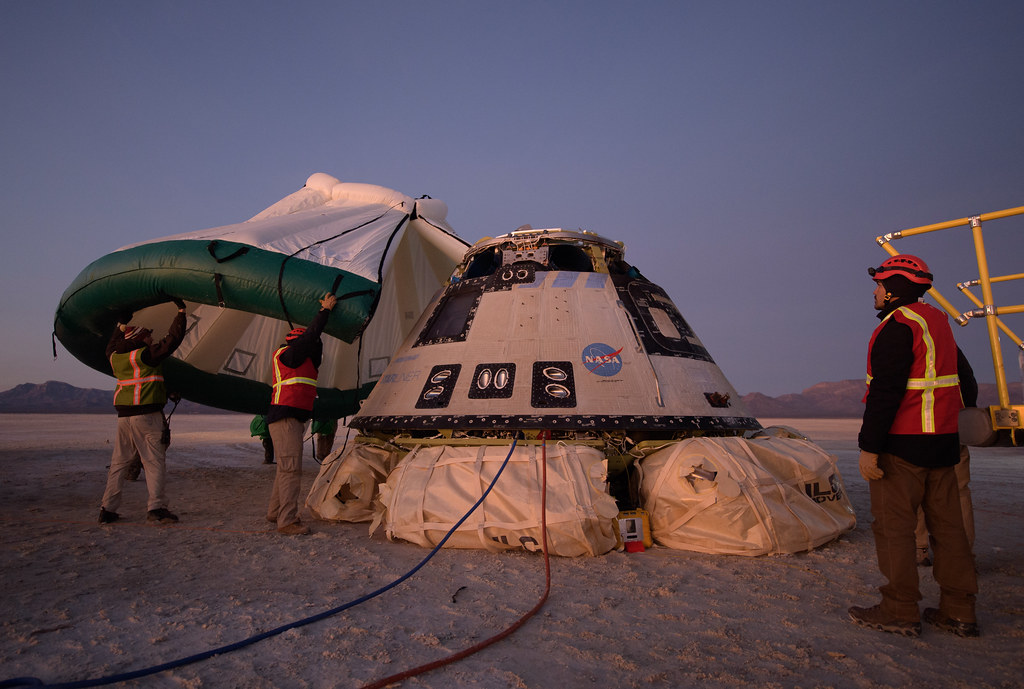 Testing Boeing's Starliner capsule.
Testing Boeing's Starliner capsule.
https:/commons.wikimedia.org/wiki/File:Crew_Dragon_Interior_(21119686299).jpg;
NASA continues to use a variety of rockets to launch satellites and planetary probes, some of these modern rockets include:
|
Rocket |
Developer |
Stages |
Maximum Payload |
First Successful Launch Date |
|
Minotaur |
Northrop Grummon |
4 |
1,735 kilograms |
September 7, 2013 |
|
Falcon 9 |
SpaceX |
2 |
22,800 kilograms |
October 8, 2012 |
|
New Shepard |
Blue Origin |
1 |
11.3 kg |
November 23, 2015 |
|
Antares |
Northrop Grummon |
2 |
8,000+ kg |
April 21, 2013 |
|
Space Launch System (SLS) |
NASA |
2, +2 boosters |
70 tonnes |
Planned for November 2021 |
|
Electron |
Rocket Lab |
2-3 |
225 kg |
25 May 2017 |
|
Falcon Heavy |
SpaceX |
2, +2 boosters |
63,800 kg |
February 6, 2018 |
|
Atlas V |
Lockheed Martin |
2, + 0-5 boosters |
8,250–20,520 kg |
August 21, 2002 |
|
Delta IV |
United Launch Alliance |
2, + 2 boosters |
11,470–28,790 kg |
November 20, 2002 |
|
Pegasus |
Orbital Sciences Corporation |
1, launched from aircraft |
443 kg |
April 5, 1990 |
|
Starship |
SpaceX |
2 |
> 100,000 kg |
Under development |
|
New Glenn |
Blue Origin |
2 |
45,000 kg |
Under development |
|
Vulcan Centaur |
United Launch Alliance |
2, +0-6 boosters |
27,200 kg |
Under development |

